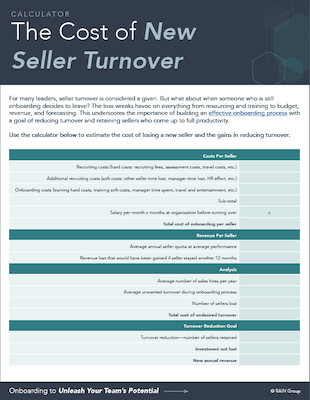Given the investment companies make in hiring, training, and managing their sales force to get maximum results, it’s imperative sales and enablement leaders understand how they can make the most of that investment and retain the best sellers once hired.
Our Top-Performing Sales Organization research, in which we analyzed data from 472 sellers and executives, revealed that the process for onboarding new sales hires and getting sellers to full productivity is strongly correlated to key measures of a well-functioning sales organization.
When a company’s onboarding process is effective:
- Sales managers are more than twice as likely to be effective at getting maximum performance from their sellers (49% vs. 23% when onboarding is not effective).
- They’re better able to retain top talent. In companies where undesired turnover is 50% or greater, nearly three-quarters of them (72%) do not have an effective onboarding process in place.
The High Cost of Sales Rep Turnover
Google the cost of turnover in sales and you’ll find a variety of articles and cost calculators to help estimate the cost of a lost salesperson. Estimated costs typically range from between 100% and 500% of a seller’s compensation, and this often doesn’t account for the revenue lost when a seller leaves the company.
The costs of losing new sellers are similarly high. Sellers tend to be a cost for the company before they become competent or top performers many months later.
For every seller hired, a company may invest hundreds of thousands of dollars over the course of several quarters, at minimum, until the seller is pulling their own weight. Multiply that by 10 sellers and you're in the millions.
Get a fillable PDF to calculate the cost of new seller turnover for your organization. →
Put the Right Systems in Place
Prioritizing retention of new hires begins by working with them closely from the outset with strong sales management and coaching. But before that, it requires creating the processes and systems for successful onboarding well before the hiring happens.
Top sales organizations outperform others in 4 key areas that correspond to successful onboarding of new sales hires:
- More effective sales management: Other research, The Top Performing Sales Manager, underscores the important role sales managers play during the onboarding and seller development process. Newer sellers with an effective manager are 240% more likely to become top-performing sellers.
- More mature sales processes, methods, and training efforts: 51% of sales organizations haven’t formally defined their sales process. That’s more than half of sales organizations. Those that do see higher proposals won and fewer proposals lost to competitors and no decision.
- More effective sales training: 71% of Top-Performing Sellers report receiving extremely or very effective sales training compared to only 45% of all other sellers.
- Stronger culture and investment in sales training: Elite and Top-Performing Sales Organizations invest more in sales training and are two times more likely to rate the training as effective. Furthermore, 66% of Top Performers say their company leaders prioritize sellers’ development of skills to be as valuable as possible to buyers.
In summary, top organizations have leaders who believe in developing sellers, invest in that development, and support seller development with defined processes and effective sales managers. This not only aids in onboarding sellers, it creates an environment for top sales performance overall.
Know the Cost of Seller Turnover
A simple analysis of the cost of sellers that turn over during their onboarding process can be fairly straightforward. While it can get much more complex than this, you can simply consider the following:
- Recruiting costs (hard costs, such as recruiting fees and assessment costs)
- Recruiting costs (soft costs, such as other seller time lost, manager time lost, and HR effort)
- Onboarding costs (training hard costs, training soft costs, manager time spent, travel and entertainment)
- Salary per month
- Months at organization before turning over
- Average seller quota at average performance
Example Analysis of Seller Turnover During Onboarding Process
|
Costs Per Seller |
|
|
Recruiting costs (hard costs, such as recruiting fees, assessment costs) |
$24,000 |
|
Additional recruiting costs (soft costs, such as other seller time |
$31,000 |
|
Onboarding costs (training hard costs, training soft costs, manager time |
$14,000 |
|
Sub-total |
$69,000 |
|
Salary per month x months at organization before turning over |
$8,333 x 10 |
|
Total |
$152,330 |
|
Revenue Per Seller |
|
|
Average annual seller quota at average performance |
$2,000,000 |
|
Revenue lost that would have been gained if seller stayed another 12 months |
$1,000,000 |
|
Analysis |
|
|
Average number of sales hires per year |
10 |
|
Average unwanted turnover during onboarding process |
40% |
|
Number of sellers lost |
4 |
|
Total costs of undesired turnover (4 x $152,330) |
$609,320 |
|
If turnover is decreased by two sellers: a $304,660 investment ($152,330 x 2) isn't lost, and two sellers can produce $4,000,000 in new revenue per annum, if retained. |
|
Download the new seller turnover calculator to learn your turnover costs. →
4 Steps for Building an Effective Seller Onboarding Process
Sales and enablement leaders can get started building an effective seller onboarding process and reduce turnover with these actions:
- Analyze the cost of losing a new sales hire to quantify what’s at stake for each new hire retained or lost. This will help you make assumptions about how increases in onboarding effectiveness can lower unwanted turnover and give you a basis for knowing how much to invest to make the improvements worthwhile. And if you’re looking to prove the ROI of current initiatives, run these calculations to make a case for your current program.
- Assess your sales managers’ effectiveness in general and in onboarding new sellers. By doing so you can uncover and implement best practices in onboarding. You’ll find certain sales managers are often much better at this than others. Leverage their expertise and focus on upskilling managers themselves, not just sellers.
- Invest in onboarding training, sales process, and sales method. When these are in place, sellers know what to do and how to go about it and have a specific plan for how to get on the right track when selling.
- Create a specific onboarding curriculum and schedule with intense focus on getting people up to speed and selling quickly. Hold sellers accountable for completing the onboarding curriculum and have sales managers facilitate discussion with sellers around key topics. Part of the curriculum and schedule should also include role plays with managers and regular coaching where managers provide feedback on seller activities (needs discovery calls, proposals, etc.). A seller's experience of being invested in and supported, combined with the increased effectiveness of the onboarding process and the faster time to ramp-up, will reduce unwanted turnover.
By taking these steps and delivering an onboarding program tailored to your organization’s sellers, you’ll get the most from your investment in new hires, retain the best sellers, and boost sales results.








